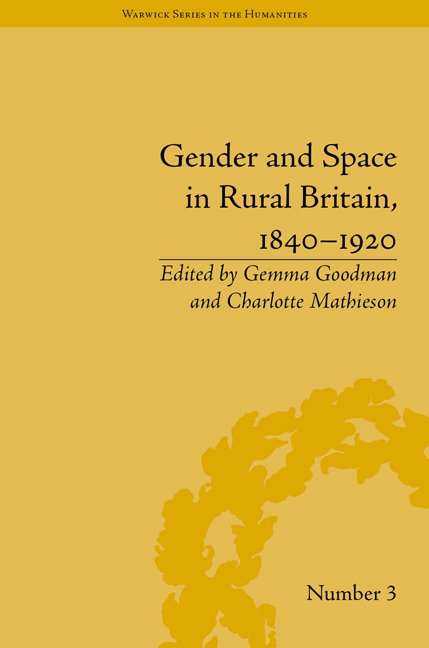Book contents
- Frontmatter
- Contents
- Acknowledgements
- List of Contributors
- Introduction: Gender and Space in Rural Britain, 1840–1920
- 1 Women in the Field
- 2 ‘Between Two Civilizations’: George Sturt's Constructions of Loss and Change in Village Life
- 3 At Work and at Play: Charles Lee's Cynthia in the West
- 4 ‘Going Out, Going Alone’: Modern Subjectivities in Rural Scotland, 1900–21
- 5 ‘Drowned Lands’: Charles Kingsley's Hereward the Wake and the Masculation of the English Fens
- 6 ‘Wandering Like a Wild Thing’: Rurality, Women and Walking in George Eliot's Adam Bede and The Mill on the Floss
- 7 ‘I Never Liked Long Walks’: Gender, Nature and Jane Eyre's Rural Wandering
- 8 Gertrude Jekyll: Cultivating the Gendered Space of the Victorian Garden for Professional Success
- 9 From England to Eden: Gardens, Gender and Knowledge in Virginia Woolf's The Voyage Out
- 10 The Transnational Rural in Alicia Little's My Diary in a Chinese Farm
- Notes
- Index
5 - ‘Drowned Lands’: Charles Kingsley's Hereward the Wake and the Masculation of the English Fens
- Frontmatter
- Contents
- Acknowledgements
- List of Contributors
- Introduction: Gender and Space in Rural Britain, 1840–1920
- 1 Women in the Field
- 2 ‘Between Two Civilizations’: George Sturt's Constructions of Loss and Change in Village Life
- 3 At Work and at Play: Charles Lee's Cynthia in the West
- 4 ‘Going Out, Going Alone’: Modern Subjectivities in Rural Scotland, 1900–21
- 5 ‘Drowned Lands’: Charles Kingsley's Hereward the Wake and the Masculation of the English Fens
- 6 ‘Wandering Like a Wild Thing’: Rurality, Women and Walking in George Eliot's Adam Bede and The Mill on the Floss
- 7 ‘I Never Liked Long Walks’: Gender, Nature and Jane Eyre's Rural Wandering
- 8 Gertrude Jekyll: Cultivating the Gendered Space of the Victorian Garden for Professional Success
- 9 From England to Eden: Gardens, Gender and Knowledge in Virginia Woolf's The Voyage Out
- 10 The Transnational Rural in Alicia Little's My Diary in a Chinese Farm
- Notes
- Index
Summary
Imagine a vast sheet of paper on which straight Lines, Triangles, Squares, Pentagons, Hexagons, and other figures, instead of remaining fixed in their places, move freely about, on or in the surface, but without the power of rising above or sinking below it, very much like shadows – only hard and with luminous edges – and you will then have a pretty correct notion of my country and countrymen. Alas, a few years ago, I should have said ‘my universe’: but now my mind has been opened to higher views of things.
E. A. Abbot, Flatland: A Romance of Many DimensionsIn 1866, Charles Kingsley published Hereward the Wake: Last of the English, a quasi-historical novel based on the life of an eleventh-century Anglo-Danish outlaw and his last stand against William the Conqueror's Norman incursion into England. Described by Graham Swift as a ‘fenland fabulist’, Kingsley opens his text with a prelude dedicated to the novel's setting, the lowlands of East Anglia. Read as a defence of the Fens against the domination of highland spaces within romantic and historical literature, Kingsley's preface usefully represents the bifurcation of British rurality, a division based on gradient. But his championing of East Anglia is partial. While the nineteenth-century flatlands were drained, cultivated and effectively tamed by engineers and agriculturists – a process initiated formally in the seventeenth century – Kingsley's medieval fens are a morass of marshlands and Dark Age superstition.
- Type
- Chapter
- Information
- Gender and Space in Rural Britain, 1840–1920 , pp. 73 - 86Publisher: Pickering & ChattoFirst published in: 2014

